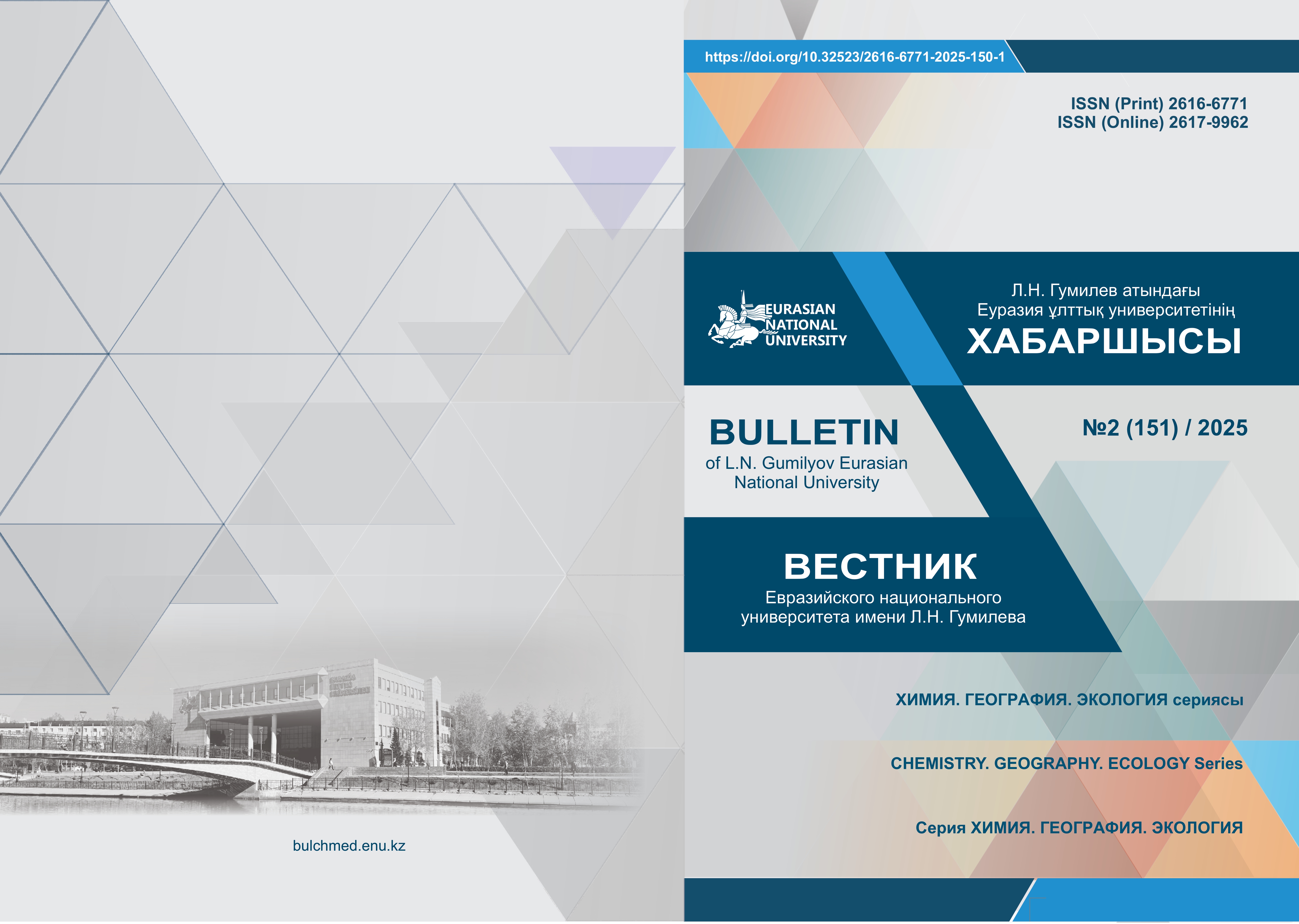Оңтүстік Алтайдың ерекше қорғауға алынған табиғи аумақтарының табиғи-рекреациялық әлеуетін бағалау
Қаралымдар: 762 / PDF жүктеулері: 98
DOI:
https://doi.org/10.32523/2616-6771-2025-151-2-169-182Кілт сөздер:
ерекше қорғалатын табиғи аумақ, ГАЖ, операциялық аумақтық бірліктер, мемлекеттік табиғи қорық, мемлекеттiк ұлттық табиғи парк, мемлекеттiк табиғи қаумал, рекреация, туризмАңдатпа
Оңтүстік Алтайдың ерекше қорғауға алынған табиғи аумақтарының экологиялық-рекреациялық әлеуетін бағалау экологиялық зерттеулер үшін маңызды бағыт болып табылады. Бұл мақалада Оңтүстік Алтай аумағындағы қорғалатын табиғи аудандардың экологиялық жағдайы мен рекреациялық мүмкіндіктері зерттелген. ГАЖ технологиясының көмегімен аймақта кездесетін табиғи, тарихи және мәдени ескерткіштердің электронды картасы құрастырылып, қорғалатын аумақтардың экологиялық жағдайы мен табиғи ресурстарының сақталуына баға берілді. Оңтүстік Алтайдың ерекше қорғалатын табиғи аумақтарының экологиялық және рекреациялық әлеуетін бағалаудың өзектілігі туризмді дамытумен қатар бірегей экожүйелерді сақтау қажеттілігімен түсіндіріледі. Зерттеуде 1:100 000 масштабтағы картографиялық материалдар, жерсеріктік қашықтықтан зондтау деректері, далалық маршруттардың нәтижелері (2015-2024 жж.) қолданылды. Біріншіден, ArcGIS бағдарламалық кешенінде қатаң қорғалатын аймақтар мен нүктелік нысандардың шекаралары (геологиялық, гидрологиялық, ботаникалық ескерткіштер) цифрландырылды, содан кейін бүкіл аумақ 5х5 км өлшемді 80 алтыбұрышты ұяшықтарға бөлінді. Әрбір ұяшық үшін атрибуттар бойынша деректер жиналды: ескерткіштердің саны мен түрі, инфрақұрылымның қолжетімділігі, антропогендік әсер ету дәрежесі. Бұл зерттеудің маңызды нәтижесі ретінде, табиғи ескерткіштерді анықтау және оларды қорғау мақсатында ерекше мәні бар аудандар көрсетілді. Катон-Қарағай табиғи ұлттық саябағы, Марқакөл қорығы және Күршім ауданындағы геологиялық ескерткіштер, атап айтқанда Қиын-Керіш және Қызыл-Керіш тастар, экологиялық тұрғыдан қорғауды қажет ететін нысандар ретінде қарастырылады. Бұл аудандардағы табиғи ескерткіштер мен табиғи ресурстар экологиялық тұрақтылықты қамтамасыз ету және аймақтың рекреациялық әлеуетін сақтау үшін ерекше маңызға ие.
Downloads
Әдебиеттер тізімі
Berlyant, A.M. Kartograficheskij metodissledovaniya [Cartographic research method]. – M.: MGU, 1988. – 252 p.
Berlyant, A.M. Geoinformacionnoe kartografirovanie [Geoinformation mapping]. – M.: Pros-veshchenie, 1997. – 64 p.
Chernykh, D.V., Glushkova, M., Pershin, D.K., Zhiyanski, M., Zinovieva, A.E., Zolotov, D.V., Lubenets, L.F., & Biryukov, R.Yu. (2021). Challenges of assessment and mapping of eco-system services in Bulgarian (Rhodope) and Russian (Altai) mountain protected areas in the context of post-socialist transformations and new conservation paradigms. Silva Bal-canica, 22(2), 43–68. https://doi.org/10.3897/silvabalcanica.22.e69861Silva Balcanica
Chervyakov, V.A. Kolichestvennyemetody v geografii [Quantitative methods in geography]. – Barnaul: Izd-voAltGU, 1998. – 260 s.
Chervyakov, V.A. Teoriya i tekhnologiya regional'nogo kartograficheskogo modelirovaniya: geoinformacionnye podhody [Theory and technology of regional cartographic modeling: geoinformation approaches]: monograph. – Barnaul: Izd-vo AltGU, 2005. – 135 s.
Chlachula, J., Zhensikbayeva, N.Zh., Yegorina, A.V., Kabdrakhmanova, N.K., & Czerniawska, J. (2021). Territorial Assessment of the East Kazakhstan Geo/Ecotourism: Sustainable Travel Prospects in the Southern Altai Area. Geosciences, 11(4), 156. https://doi.org/10.3390/geosciences11040156MDPI
Dirin, D.A., Krupochkin, E.P., Golyadkina, E.I. Metodikakompleksnojocenkituristko-rekreacionnogopotencialaregiona[Methodology of comprehensive assessment of the tourist and recreational potential of the region] // Geografiyaiprirodopol'zovanieSibiri. – 2014. – №18. – P. 64-78.
Dunec, A.N. Territorial'naya organizaciya gornyh turistsko-rekreacionnyh sistem: naprimere Altae-Sayanskogo regiona [Territorial organization of mountain tourist and recreational systems: on the example of the Altai-Sayan region]: monograph. – Barnaul: AltGTU, 2009. – 167 p.
Dunec, A.N. Tekhnologii turistsko-rekreacionnogo proektirovaniyai osvoeniya territorij [Tech-nologies of tourist and recreational design and development of territories]: a textbook / AGTU I.I. Polzunova. – Barnaul: AZBUKA, 2011. – 153 p.
Foody, G.M., & See, L. (2006). Data uncertainty in the context of remote sensing and GIS. In-ternational Journal of Remote Sensing, 27(4), 733–736. https://doi.org/10.1080/01431160500251902
García-Hernández, M., de la Calle-Vaquero, M., &Yubero, C. (2017). Cultural heritage and urban tourism: Historic city centres under pressure. Sustainability, 9(8), 1346. https://doi.org/10.3390/su9081346
Gartner, G., & Huang, H. (2018). From conceptual modeling to a map: Cartographic perspec-tives. Proceedings of the ICA, 1, 49. https://doi.org/10.5194/ica-proc-1-49-2018
Geneletti, D. (2013). A GIS-based approach for mapping recreation and tourism potential in protected areas. Landscape and Urban Planning, 111, 1–10. https://doi.org/10.1016/j.landurbplan.2012.11.003
Janelle, D.G., Goodchild, M.F., & Klinkenberg, B. (2003). Spatially Integrated Social Science: Examples in Best Practice. Oxford University Press.https://escholarship.org/content/qt7wp0k0bb/qt7wp0k0bb_noSplash_6a9027530ed318eeea115a8eeab48e87.pdf
Kraak, M.J., &Ormeling, F. (2020). Cartography: Visualization of Geospatial Data (4th ed.). Routledge.https://doi.org/10.1201/9780429464195
Krupochkin, E.P., Dirin, D.A., Popov, E.S., Dunec, A.N. Rezul'taty aprobaci inovoj metodiki kompleksnoj ocenki turistko-rekreacionnogo potenciala: naprimere lentochnyh borov Altajskogo kraya [The results of testing a new methodology for the comprehensive as-sessment of tourist and recreational potential: on the example of ribbon forests of the Altai Territory] // Izvestiya AltGU. – 2012. – №3/2. – P. 245-255.
Kulikova, A., Latysheva, O., &Kotelnikova, A. (2023). Approaches to the design of tourist ar-eas: the experience of the Altai Territory. Bulletin of the L.N. Gumilyov Eurasian National University. Chemistry. Geography. Ecology Series, 143(2), 60–70. https://doi.org/10.32523/2616-6771-2023-143-2-60-70bulchmed.enu.kz
Longley, P.A., Goodchild, M.F., Maguire, D.J., & Rhind, D.W. (2021). Geographic Infor-mation Science and Systems (5th ed.). Wiley.https://www.geos.ed.ac.uk/~gisteac/gis_book_abridged/files/00_fm.pdf
Mammadova, A., Redkin, A., Beketova, T., & Smith, C.D. (2022). Community Engagement in UNESCO Biosphere Reserves and Geoparks: Case Studies from Mount Hakusan in Japan and Altai in Russia. Land, 11(2), 227. https://doi.org/10.3390/land11020227MDPI
Minghini, M., & Brovelli, M. A. (2019). OpenStreetMap history for intrinsic quality assess-ment: Is OSM up-to-date? Open Geospatial Data, Software and Standards, 4(9). https://doi.org/10.1186/s40965-019-0067-x
Nepal, S. K. (2002). Mountain ecotourism and sustainable development: Ecology, economics, and ethics. Mountain Research and Development, 22(2), 104–109. https://doi.org/10.1659/0276-4741(2002)022[0104:MEASDE]2.0.CO;2
Osobo ohranyaemye prirodnye territoriii ob"ekty Altajskogo kraya: karta masshtaba M 1: 1 000 000 [Specially protected natural territories and objects of the Altai Territory: a map of a scale of M 1: 1,000,000]/ edited by I.N. Rotanova, L.N. Purdik, Yu.I. Vinokurova et al. – Barnaul, 2002. – P. 35.
Rotanova, I.N., Harlamova, N.F. Turistko-rekreacionnyj kompleks Altajskogo regiona: organi-zaciyai informacionno-kartograficheskoe obespechenie [Tourist and recreational complex of the Altai region: organization and information and cartographic support]: monograph. – Barnaul: AltGU, 2014. – 212 p.
Sehra, S., Singh, J., & Rai, H. (2017). Assessing OpenStreetMap data using intrinsic quality indicators: An extension to the QGIS processing toolbox. Future Internet, 9(2), 15. https://doi.org/10.3390/fi9020015
Simangan, D.A., & Eslava, J.L. (2023). A mathematical model for assessing tourism potential in protected areas. Tourism Management, 94, 104660. https://doi.org/10.1016/j.tourman.2022.104660
Tikunov, V.S. Modelirovanie v kartografii [Modeling in cartography]. – M.: MGU, 1997. – 235 p.
UNEP-WCMC. (2023). World Database on Protected Areas (WDPA). Retrieved from https://www.protectedplanet.net
Vancura, V. (2016). Wilderness and tourism in Altai Mountains, Kazakhstan. European Wil-derness Society. Retrieved from https://wilderness-society.org/wilderness-tourism-altai-mountains-kazakhstan/European Wilderness Society
Zoltan, J., & Bausch, T. (2016). Tourism planning and development in mountainous areas: Challenges and approaches. Tourism Geographies, 18(3), 306–323. https://doi.org/10.1080/14616688.2016.1144643
Жүктеулер
Жарияланды
Журналдың саны
Бөлім
Лицензия
Авторлық құқық (c) 2025 Nazgul Zhensikbayeva, Nurgul Ramazanova, A. Yeginbayeva, Nazerke Amangeldy (Author)

Бұл жұмыс Creative Commons Attribution-Коммерциялық емес 4.0 халықаралық лицензиясы.








